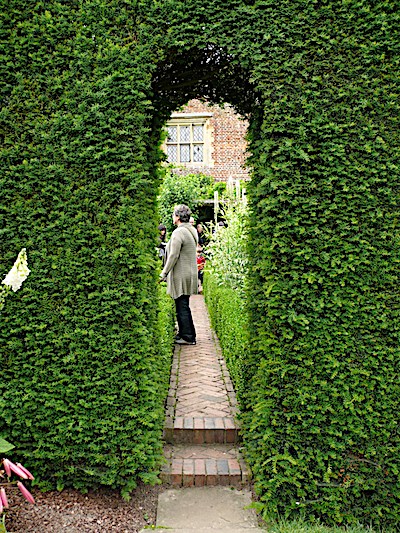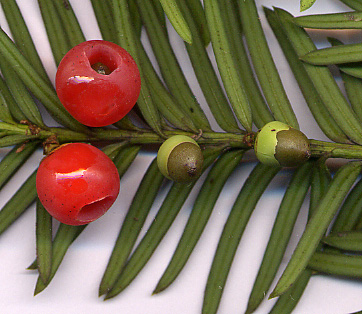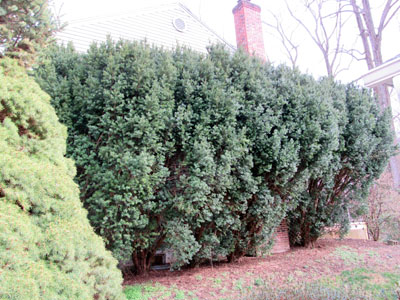I Know All About Yews
By Elaine Homstad, Fairfax Master Gardener
 What do you know about yews? You might be surprised that you don’t know as much about yews as you thought you did.
What do you know about yews? You might be surprised that you don’t know as much about yews as you thought you did.
Yews are a group of conifers in the family Taxaceae. The genus Taxus has over 400 named cultivars, most derived from either the English (aka European) yew (Taxus baccata) or the Japanese yew (Taxus cuspidata). The hybrid variety of these two is the Taxus x media, known as either the Anglojap or Foundation yew.
Yews are very widely used in landscaping as foundation or specimen plants, and often as a hedge. They are also valued as ornamentals which can be sculpted, through artistic pruning, into highly creative shapes (topiaries) and even walls and doorways. Some of the best examples of this can be seen in England.
The wood of a yew is very springy and flexible and was traditionally used to make bows, particularly the longbow, a very predominant weapon during the Middle Ages.
Though all yews are basically similar in their characteristic appearance with soft evergreen needles, reddish-brown flexible wood, small orange-red berries and dense growth habit, there are many cultivars to choose from, making them an ideal choice for the home landscape.

Yew needles & berry
With so many cultivars, they can grow in different ways also. There are pyramidal, columnar, upright, spreading or rounded. Some grow only as tall as 1 to 2 feet, while other varieties can reach heights of 25 to 40 feet or more. Spreads can also vary between 3 and 10 feet.
One of the things that makes them so desirable is their low-maintenance value. Generally speaking, yews are long-lived, slow-growing plants that can survive and thrive under a variety of conditions — sun, shade, drought — and soil types. They are very adaptable and for the most part pest and disease resistant.
Most yews can grow in Zones 4 through 7. They cannot tolerate excessive heat, so they are not a plant for southern climates. They also cannot tolerate continuously wet feet and must be planted in a well-drained area. They are less susceptible to winter damage from ice and snow because of the flexibility of their branches. Even after being weighed down by a heavy wet snow, they will spring back into shape once it falls away. They have the ability to survive hard pruning, grow back on bare branches, and retain a dense interior.
So, can we call a yew a perfect plant? Well, there are a few cautions of which you should be aware. Since yews are conifers, they don’t produce flowers, but rather cones. They are also separate male and female plants, and the male produces only pollen, while the female produces only fruit. The pollen can be quite abundant on the shrub, producing puffs of yellow clouds with only the slightest brush or breeze. Those with seasonal pollen allergies should avoid planting male varieties or, particularly if you want the berries on your female plants, put them in a less-frequented area.
Additionally, yew plants create an extremely toxic compound in all parts of the plant, except for the fleshy red fruit the females produce. This toxin is harmful (and even deadly in large enough quantities) to humans and most animals. Most of the toxin is contained in the stems and needles, and some animals have adapted to this. Others eat only the berries’ flesh and cannot digest the hard, toxic seed inside it. Therefore, it is best to be mindful of dogs and children who might try to eat them. Do not use a limb from a yew to play Fetch with Fido!

Hicks yews grow very tall
Yews can be used in the landscape to replace boxwoods, arborvitae and privets. Some popular and easy-to-find varieties include ‘Hicksii,’ Hicks Yew (large, tall, upright), ‘Densiformis,’ ‘Brownii’ (short, rounded), ‘Hatfieldii’ (tall, pyramidal) and ‘Tauntonii’ (spreading).
So, isn’t it time for you to grow a yew?
References
Taxus Genus (Yew), American Conifer Society
English Yew, Virginia Tech Dendrology
Taxus x media, Anglojap Yew, University of Connecticut College of Agriculture